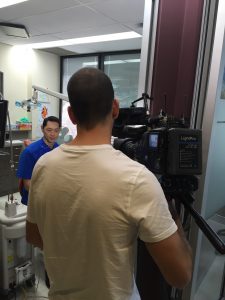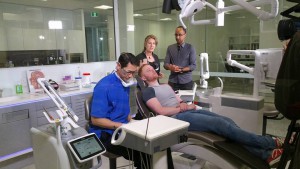MEDIA
Nine News story on NightLase laser treatment by Dr Jason Pang
24th June 2016
A Nine News crew came in to interview a patient and myself about the NightLase laser snoring treatment. They were interested to see whether it worked and spoke to one of our patients that had a successful treatment. After that I was interviewed about the treatment and how it works to stop snoring and help patients and their partners sleep better. They also got some footage of the laser in action. About 40 min of footage resulted in a 2 min segment. Enjoy!
How To Stop Snoring With New Laser Snoring Treatment
The fitness and wellness industries understand the importance of adequate, quality sleep. Snoring impacts about 40% of people leading to disturbed sleep for individuals and their partners. The NightLase anti-snoring treatment helps reduce the duration and volume of snoring without any surgery, anaesthetic, or downtime. Opening of the airways leading to better breathing, improved sleep and better health.
Live demo of dental laser at AADFA Aestheticon conference Sept 2015
Dr Jason Pang, Dr Hisham Abdalla and Dr Lisa Martriste were invited to demonstrate the aesthetic procedures that are possible with the new Lightwalker AT S dental laser at the first Australasian Academy of Dento-Facial Aesthetics AADFA Aestheticon conference. This conference hosted the best speakers in the dental world to focus on the progressive technologies, techniques and materials in regard to aesthetic dentistry.
From the Sirona HQ, the demos on live patients were beamed to The Star where the delegates were gathered. Intraoral tightening for naso-labial folds and marionette lines, lipase lip plumping and NightLase anti-snoring treatment were shown.
Bite Magazine Education Story – Join the leaders in innovation and diversification
Biowell Compact Disinfection Unit
![]()
bitemagazine.com.au
by Dr Jason Pang, Cosmic Smile Dental, Neutral Bay, NSW
Ozone is nature’s bleach and a natural disinfectant. It kills bacteria, fungi, viruses and it does it very quickly. This unit is mounted on the wall in our sterile area and produces ozonated water on demand.
What’s good about it
Dental water lines can contain a huge amount of bacteria if there are no flush and clean protocols in place. This bacteria doesn’t affect most people but if you are dealing with immuno-compromised individuals, it can be dangerous. We decided to see what difference ozonated water makes.
After a weekend, we tested the water in our lines on a Monday morning. The lines were full of bacteria and there was obviously room for improvement. When we flushed the lines with ozonated water and used ozonated water throughout the day, the test showed that no bacteria was present.
We also use the ozonated water in a number of other ways. Every patient has a preoperative mouth rinse of ozonated water. For perio patients, we use ozonated water in conjunction with deep ultrasonic scaling. This helps activate the ozone and causes a bacterial killing process. We use it for irrigating endodontic procedures and we flush any perio pockets with the water. We also used it to clean all instruments and wipe down chairs and surfaces.
On top of this, there was an unexpected side effect to using ozonated water. Our dental suite is positioned in a building that doesn’t have underfloor sewage but instead uses a series of pumps. There was one drain in the lab that always smelled bad. The use of ozonated water caused that smell to completely disappear.
What’s not so good
The unit is expensive to purchase. There can also be extra costs depending on the set-up of the surgery and whether the unit is plumbed into the water lines of the dental chair.
Where did you get it
What Business Does Kindness Have In Business?

www.newsmaker.com.au
BNI Middle Harbour is the first of the 6,600 BNI chapters representing 170,000 members in 58 countries worldwide to join the global campaign for a Kinder World thanks to a local initiative, Feel Good Feb.
The chapter will be hosting a Signing Ceremony on the 8th of May in the presence of special guests including the General Secretary to the World Kindness Movement, the peak global body, local community and business leaders. The City of Sydney and Gold Coast along with numerous local Councils, Schools, businesses and NFP organisations across Australia have already taken the first step and signed Declarations of Support since Australia was elected at the London 2012 General Assembly to spearhead global strategies to create a kinder world.
Locally “Kindness is Catching” is finding its way to the Northern Beaches inspired by the success of a grass roots campaign, Feel Good Feb (ref Manly Daily Jan 2015) which started with a local Manly mum, Linda Pang, who wanted good news stories to refocus media coverage from the negative to the positive. Mrs Pang joins an impressive list of recipients of the Cool To Be Kind Award along with Dame Marie Bashir and City of Sydney Councillor, Christine Forster.
During the Feel Good Campaign BNI Middle Harbour executive embraced the Kindness Movement and invited special guest speaker, Mr Michael Lloyd-White Chairman of World Kindness Australia and General Secretary of the peak global body, the World Kindness Movement to address its members and VIP guests. “The World Kindness Movement engages nations and organisations from all sectors to participate in a global campaign for a kinder world and BNI is an ideal candidate to become an agent for positive change” says Mr Lloyd-White. “Business has an important role to play to create positive change and it’s not about making donations, it’s about being engaged in your community. Kindness is not about flowers and hearts it is often about taking the path of most resistance and often requires courage to seek the kinder option.”
BNI Middle Harbour President, Pru Chapman
“As a local business group we feel that we can have a greater impact and wanted to put our collective energies into a positive future. As a group we were captured and inspired by the World Kindness Movement and see this as a great step in moving towards a friendlier future in which we recognise and are grateful for one another. We hope that in taking up this initiative we can inspire other local businesses to do the same, and spread the kindness movement through the Northern Beaches and beyond.”
BNI Middle Harbour Vice-President, Jason Pang
“We believe that having kindness as a core value of business will build stronger long-term relationships with clients, suppliers and the local community. It provides direction and acts as a moral compass for business to act in a socially responsible way instead of focusing solely on the bottom line. Individually the member business will have kindness as a principle tenet, and collectively we will support kindness initiatives to contribute towards creating a kinder world.”
BNI Middle Harbour meet weekly at Balgowlah to collaborate, share ideas and network to support local business members. For more information please visit http://www.myteam.net.au
Background World Kindness Posted WKA FB 10th April 2015
“Just a quick update since Feel Good Feb campaign we welcome Konica Minolta as a new corporate member, Caring for You Nursing Agency Melbourne, William Roberts Lawyers and NSW Parents’ Council and BNI Middle Harbour as our newest members. World Kindness Movement International Council Meeting last night, which we chaired in our capacity as Secretariat. Apart from Australia this includes China, France, India, Korea, Nigeria, Switzerland, Thailand and USA, which comprise the international board. We will be attending the official launch of World Kindness France in Avignon on 27th June and facilitating a 2-day workshop and Council Meeting on developing global strategies to create a kinder world as a prelude to the world leaders’ summit the K20. The London Times contacted our office as part of a feature story they are doing on the growing global campaign and social media buy in which we look forward to sharing. If your organisation or city/council is looking to participate and support this global campaign please contact us at ambassador@worldkindnessaustralia.org”











